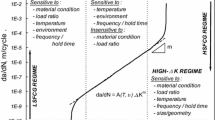Experimental studies on the effect of transient heating of the outer surface of radial crack-containing ring specimens from 45 steel on their fracture toughness are described. Such a treatment contributes to an increase in brittle fracture resistance at low temperature. As numerical simulation results demonstrated, transient heating of the outer specimen surface results in localized plastic flow near the crack tip, leading to strain hardening and its blunting.










Similar content being viewed by others
References
G. G. Chell, J. R. Haigh, and V. Vitek, “A theory of warm prestressing: experimental validation and implications for elastic plastic failure criteria,” Int. J. Fract., 17, No. 1, 61–81 (1981).
D. A. Curry, “A micromechanistic approach to the warm pre-stressing of ferritic steels,” Int. J. Fract., 17, No. 3, 335–343 (1981).
V. V. Pokrovsky, V. T. Troschenko, V. G. Kaplunenko, et al., “A promising method for enhancing resistance of pressure vessels to brittle fracture,” Int. J. Press. Vess. Piping, 58, 9–24 (1994).
V. V. Pokrovskii and A. G. Ivanchenko, “Influence of the modes of thermomechanical preloading on the resistance of heat-resistant steels to brittle fracture,” Strength Mater., 31, No. 2, 200–209 (1999).
V. V. Pokrovskii and A. G. Ivanchenko, “Prediction of the warm prestressing effect on an increase in the brittle strength of crack-containing heat-resistant structural steels. Part 1. Model and procedure of calculating the warm prestressing effect,” Strength Mater., 34, No. 6, 598–605 (1999).
D. J. Smith, S. Hadidimoud, and H. Fowler, “The effects of warm pre-stressing on cleavage fracture. Part 1: Evaluation of experiments,” Eng. Fract. Mech., 71, 2015–2032 (2004).
D. J. Smith, S. Hadidimoud, and H. Fowler, “The effects of warm pre-stressing on cleavage fracture. Part 2: Finite element analysis,” Eng. Fract. Mech., 71, 2033–2051 (2004).
R. Rintamaa, K. Wallin, H. Keinanen, et al., “Consistence of fracture assessment criteria for the NESC-1 thermal shock test,” Int. J. Press.Vess. Piping, 78, 125–135 (2001).
Pressurized Thermal Shock in Nuclear Power Plants: Good Practices for Assessment, IAEA-TECDOC-1627, IAEA, Vienna (2010).
V. T. Troshchenko, V. V. Pokrovs’kyi, V. Yu. Podkol’zyn, et al., Method of Enhancing the Crack Propagation Resistance of Structures [in Ukrainian], Patent of Ukraine No. 18927A, C 21 D 7/02. Publ. December 25, 1997. Bull. No 6.
V. V. Pokrovs’kyi, M. O. Shteinberg, V. K. Bronnikov, et al., Equipment for the Thermal Treatment of Vessel Structures [in Ukrainian], Patent of Ukraine No. 21758A, C 21 D 9/08. Publ. April 30, 1998. Bull. No 2.
C. E. Pugh and B. R. Bass, A Review of Large-Scale Fracture Experiments Relevant to Pressure Vessel Integrity under Pressurized Thermal Shock Conditions, NUREG/CRORNL/TM-2000/360 (2000).
H. Chen, V. B. Wang, G. Z. Wang, and X. Chen, “Mechanism of effects of warm prestressing on apparent toughness of precracked specimens of HSLA steels,” Eng. Fract. Mech., 68, 1669–1686 (2001).
E399-90. Standard Test Method for Plane-Strain Fracture Toughness of Metallic Materials , ASTM (1997).
ANSYS HTML. Online Documentation, SAS IP Inc. (2005).
A. A. Kotlyarenko, T. A. Prach, V. V. Kharchenko, and A. Yu. Chirkov, “Numerical simulation of stress-strain state near crack tip in a compact tensile specimen,” Strength Mater., 41, No. 1, 106–112 (2009).
C. L. Tsai, W. L. Dai, D. W. Dickinson, and J. C. Papritan, “Analysis and development of a real-time control methodology in resistance spot welding,” Weld. J., 70, 339–351 (1991).
Author information
Authors and Affiliations
Additional information
Translated from Problemy Prochnosti, No. 4, pp. 112 – 123, July – August, 2012.
Rights and permissions
About this article
Cite this article
Stepanov, G.V., Kharchenko, V.V., Kotlyarenko, A.A. et al. Effect of transient heating of the outer surface of a radial crack-containing ring specimen on its brittle fracture resistance. Strength Mater 44, 429–437 (2012). https://doi.org/10.1007/s11223-012-9397-y
Received:
Published:
Issue Date:
DOI: https://doi.org/10.1007/s11223-012-9397-y




